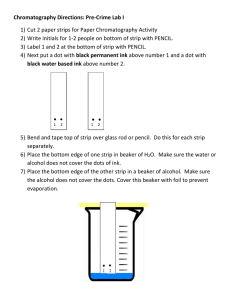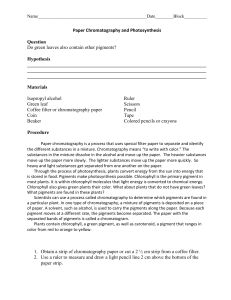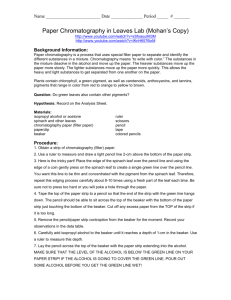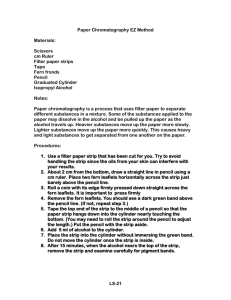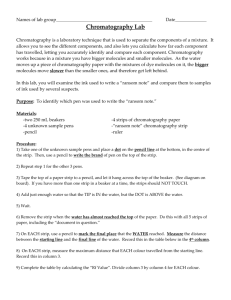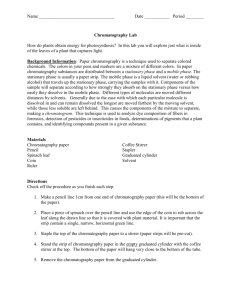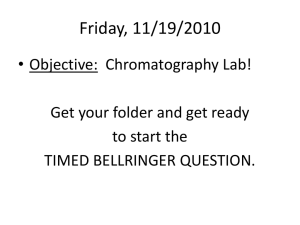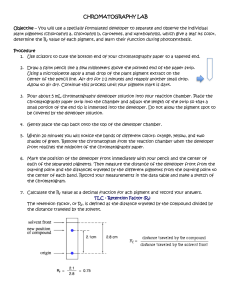After paper chromatography
advertisement
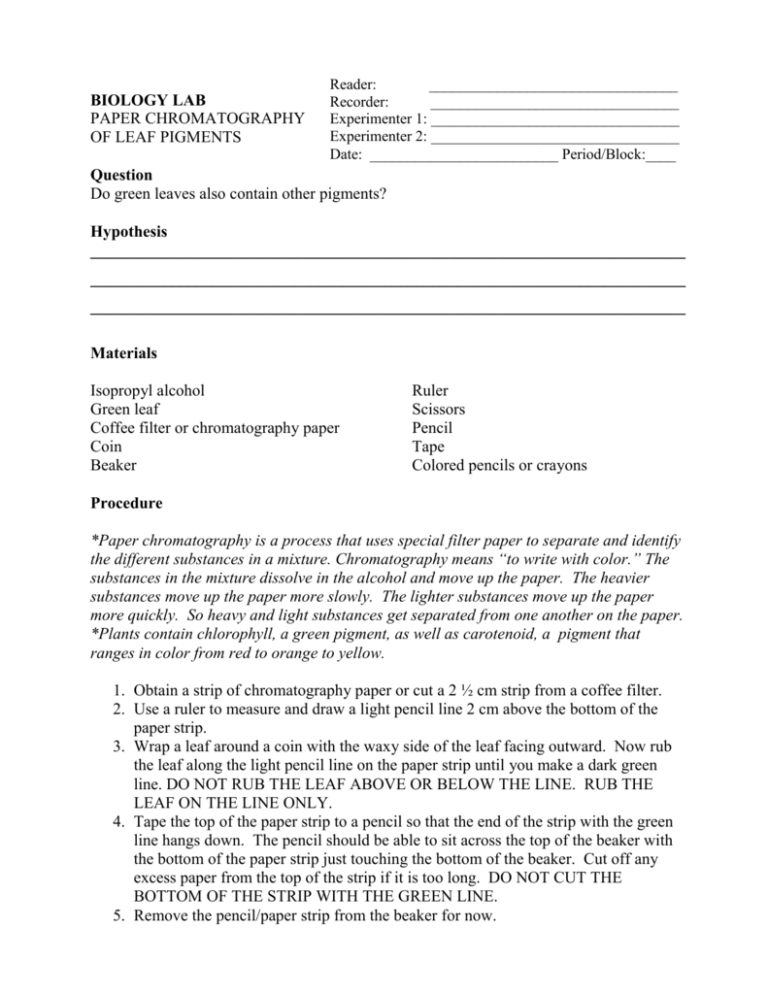
BIOLOGY LAB PAPER CHROMATOGRAPHY OF LEAF PIGMENTS Reader: _________________________________ Recorder: _________________________________ Experimenter 1: _________________________________ Experimenter 2: _________________________________ Date: _________________________ Period/Block:____ Question Do green leaves also contain other pigments? Hypothesis _________________________________________________________________________ _________________________________________________________________________ _________________________________________________________________________ Materials Isopropyl alcohol Green leaf Coffee filter or chromatography paper Coin Beaker Ruler Scissors Pencil Tape Colored pencils or crayons Procedure *Paper chromatography is a process that uses special filter paper to separate and identify the different substances in a mixture. Chromatography means “to write with color.” The substances in the mixture dissolve in the alcohol and move up the paper. The heavier substances move up the paper more slowly. The lighter substances move up the paper more quickly. So heavy and light substances get separated from one another on the paper. *Plants contain chlorophyll, a green pigment, as well as carotenoid, a pigment that ranges in color from red to orange to yellow. 1. Obtain a strip of chromatography paper or cut a 2 ½ cm strip from a coffee filter. 2. Use a ruler to measure and draw a light pencil line 2 cm above the bottom of the paper strip. 3. Wrap a leaf around a coin with the waxy side of the leaf facing outward. Now rub the leaf along the light pencil line on the paper strip until you make a dark green line. DO NOT RUB THE LEAF ABOVE OR BELOW THE LINE. RUB THE LEAF ON THE LINE ONLY. 4. Tape the top of the paper strip to a pencil so that the end of the strip with the green line hangs down. The pencil should be able to sit across the top of the beaker with the bottom of the paper strip just touching the bottom of the beaker. Cut off any excess paper from the top of the strip if it is too long. DO NOT CUT THE BOTTOM OF THE STRIP WITH THE GREEN LINE. 5. Remove the pencil/paper strip from the beaker for now. 6. Carefully add isopropyl alcohol to the beaker until it reaches a depth of 1 cm in the beaker. 7. Lay the pencil across the top of the beaker with the paper strip extending into the alcohol. MAKE SURE THAT THE LEVEL OF THE ALCOHOL IS BELOW THE GREEN LINE ON YOUR PAPER STRIP. IF THE ALCOHOL IS GOING TO COVER THE GREEN LINE, POUR OUT SOME ALCOHOL BEFORE YOU GET THE GREEN LINE WET. 8. Observe as the alcohol gets absorbed and travels up the paper. This may take up to 20 minutes. Do not touch your experiment during this time. 9. Using colored pencils or crayons, draw your results. Results Filter paper Before paper chromatography After paper chromatography Use colored pencils or crayons to draw your observations Conclusions 1. Why is paper chromatography an appropriate technique to use to determine if different pigments are present in a leaf? ______________________________________________________________________ ______________________________________________________________________ ______________________________________________________________________ ______________________________________________________________________ 2. How does paper chromatography work? ______________________________________________________________________ ______________________________________________________________________ ______________________________________________________________________ ______________________________________________________________________ ______________________________________________________________________ ______________________________________________________________________ 3. Did the leaf you tested contain different pigments? Use your results to support your answer. ______________________________________________________________________ ______________________________________________________________________ ______________________________________________________________________ ______________________________________________________________________ 4. Based on what you have learned, explain why leaves tend to change color in the fall. ______________________________________________________________________ ______________________________________________________________________ ______________________________________________________________________ ______________________________________________________________________ ______________________________________________________________________ ______________________________________________________________________ ______________________________________________________________________ ______________________________________________________________________ 5. Leaves in New England change color in the fall. However, leaves in Florida do not change color in the fall. Why is this so? (Hint: Think of a difference between the two locations that might act as a trigger for leaves to change color in the fall.) ______________________________________________________________________ ______________________________________________________________________ ______________________________________________________________________ ______________________________________________________________________ ______________________________________________________________________ ______________________________________________________________________ ______________________________________________________________________ ______________________________________________________________________ ______________________________________________________________________ 6. Was your hypothesis correct? If not, rewrite your hypothesis here so that it is correct. ______________________________________________________________________ ______________________________________________________________________ ______________________________________________________________________ ______________________________________________________________________
